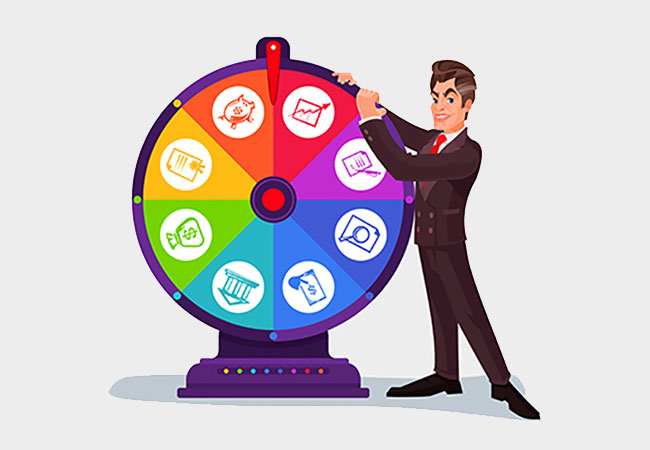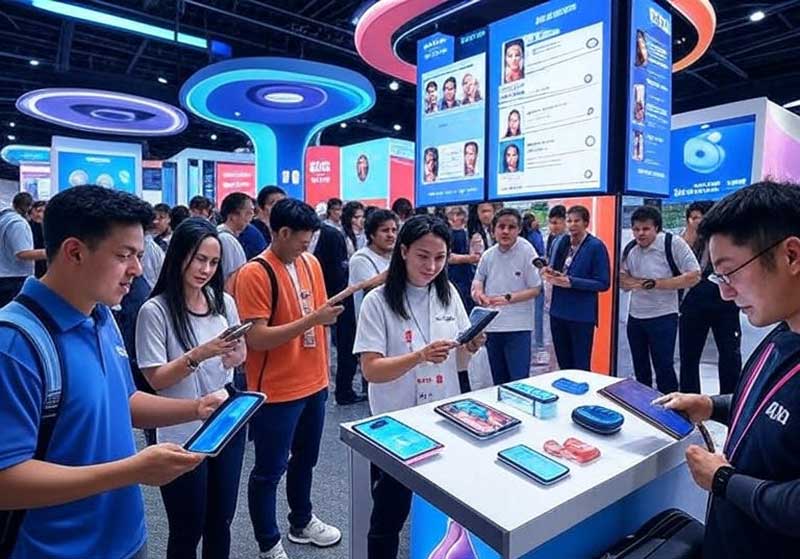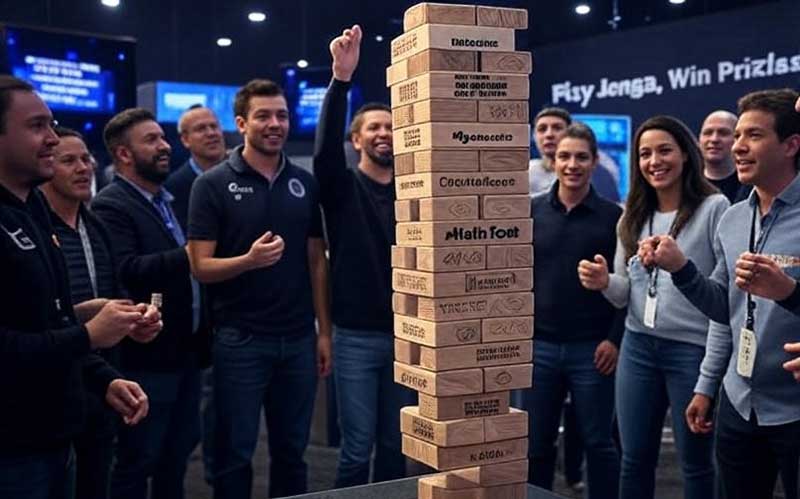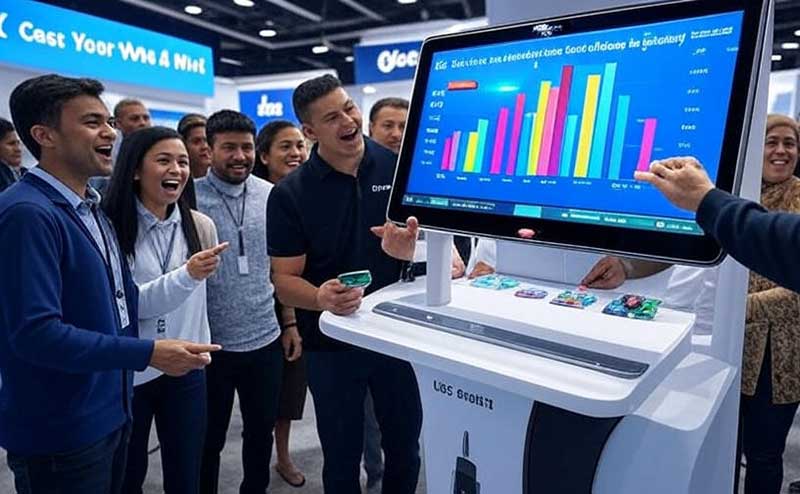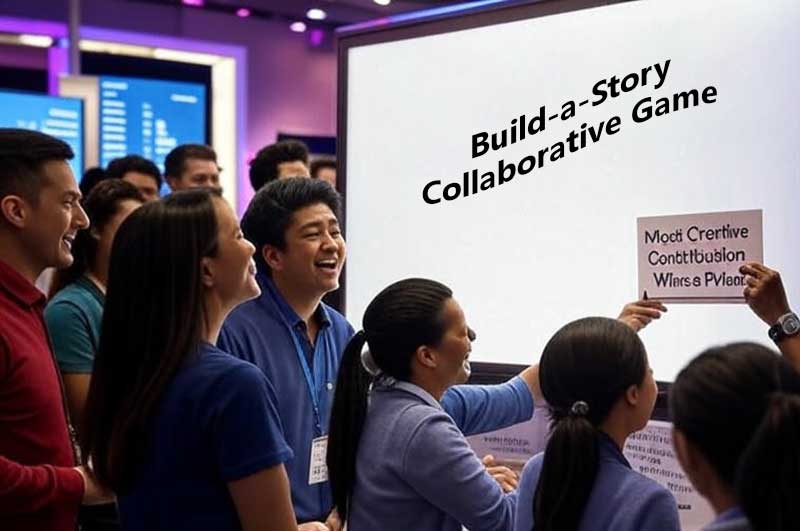Most people in the event management industry will have the experience that exhibition plans tend to be revised repeatedly. This is the rule rather than the exception in this industry.
I ever met an event planner, he is laughing at himself and said: “If I am not revising an exhibition plan, then most probably I am on the way to having a meeting with clients on revising the exhibition plan.
It is still an unsolved mystery whether the final plan that has been revised many times will actually improve the actual effect of the exhibition or not.
Generally, the major issues to be solved in an exhibition plan are the following:
- How to attract more visitors.
- Make visitors stick to the booth.
- Convert the visitors who come to the booth to become clients.
Engaging visitors with creative games is a winning strategy for trade shows. Here are 5 creative game ideas you can include:
1. Spin the Prize Wheel with a Twist
Instead of a standard prize wheel, make the segments relate to your company’s offerings or industry keywords. Landing on a specific segment could trigger a trivia question about your product or a fun fact related to your field. Correct answers win better prizes.
Core Concept: This game takes the familiar and engaging mechanic of a prize wheel and elevates it by integrating elements that subtly reinforce your brand messaging and test visitor knowledge. It’s not just about winning a random trinket; it’s an opportunity for a mini-engagement with your company’s expertise.
Key Elements of the “Twist”:
Themed Wheel Segments: Instead of generic prize labels like “T-shirt” or “Stress Ball,” customize the wheel segments with words or short phrases directly related to:
- Your Product Features/Benefits: For example, if you sell CRM software, segments could read “Boost Sales,” “Improve Customer Retention,” “Streamline Workflow,” “Data-Driven Insights.”
- Industry Keywords/Concepts: If you’re in the renewable energy sector, segments might say “Solar Power,” “Sustainability,” “Energy Efficiency,” “Carbon Footprint.”
- Humorous or Intriguing Teasers: Include a few segments that pique curiosity, like “Secret Demo,” “Ask Me Anything,” or “Industry Trivia Challenge.”
- Triggering the Trivia: The real twist comes when the wheel lands on specific “trigger” segments (you can decide how many). Instead of automatically winning the prize associated with that segment, the visitor is presented with a relevant trivia question.
* Question Difficulty: You can vary the difficulty of the questions based on the potential prize or the level of engagement you’re aiming for. Easy questions for smaller prizes, more challenging ones for grander rewards.
* Question Format: Keep the questions concise and multiple-choice for quick engagement. Display them on a tablet or screen next to the wheel.
Prize Tiers Based on Knowledge: This is where you reward engagement and knowledge:
- Standard Spin Prizes: Segments that don’t trigger trivia can offer standard branded giveaways (pens, notepads, etc.).
- Trivia-Linked Prizes: Winning the trivia question unlocks better prizes associated with the wheel segment. For example, landing on “Boost Sales” and answering a question about your sales analytics feature correctly could win a higher-value item like a discount code, a premium content download, or even entry into a grand prize drawing.
- Consolation Prizes: Even if a visitor gets the trivia wrong, offer a small consolation prize to keep the interaction positive.
How it Attracts Visitors:
- Familiarity with a Twist: The prize wheel is instantly recognizable and appealing. The added trivia element creates intrigue and a sense of challenge.
- Perceived Value: Visitors understand that they have a chance to win better prizes by demonstrating a little knowledge, making the interaction feel more rewarding than just random chance.
- Subtle Education: The themed wheel segments and trivia questions gently introduce or reinforce key aspects of your company and industry.
- Engagement and Interaction: It encourages a brief conversation with your booth staff as they administer the trivia and explain the prizes.
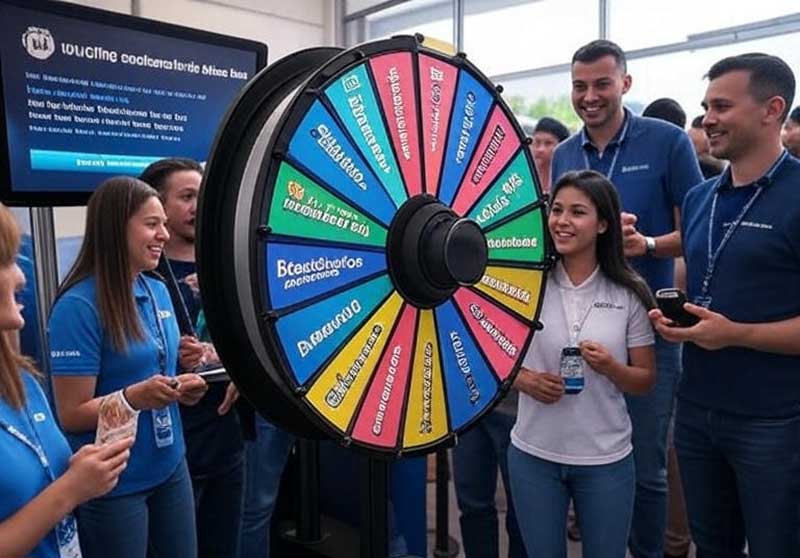
Example Scenario:
Imagine a company selling project management software. Their prize wheel has segments like “Gantt Charts,” “Task Management,” “Team Collaboration,” “Resource Allocation,” and “Project Reporting.”
- A visitor spins and lands on “Team Collaboration.”
- A booth staff member presents a trivia question: “Which feature in our software allows real-time file sharing among team members? (a) Task Dependencies, (b) Shared Workspaces, (c) Progress Tracking.”
- If the visitor answers correctly (b), they win a premium branded notebook. If they had just landed on a segment like “Gantt Charts” without triggering trivia, they might have won a branded pen.
Tips for Implementation:
- Make the Wheel Visually Appealing: Use bright colors and clear, concise text for the segments.
- Keep Trivia Engaging and Not Too Difficult: The goal is to educate, not to stump visitors.
- Train Your Booth Staff: Ensure they can smoothly explain the rules and administer the trivia.
- Promote the Game: Highlight the “Spin the Prize Wheel with a Twist” in your pre-show marketing and with clear signage at your booth.
By elaborating on these aspects, you can effectively showcase how this game is more than just a fun diversion—it’s a strategic tool for engagement and brand reinforcement. Good luck with your article!
2. Augmented Reality Scavenger Hunt
Hide virtual clues or company logos around your booth that visitors can find and collect using a dedicated AR app on their smartphones or tablets. Each collected item could unlock a small prize or entry into a larger raffle. This leverages technology and encourages exploration of your entire booth space.
Alright, let’s delve into the exciting possibilities of an “Augmented Reality Scavenger Hunt” for your trade show booth. This game leverages the power of AR to create an engaging, interactive experience that draws visitors into your space and encourages exploration.
Core Concept: Instead of physical items, this game involves hiding virtual “clues,” company logos, product representations, or even animated characters within or around your booth area. Visitors use a dedicated mobile app on their smartphones or tablets to find and “collect” these virtual elements. Each successful collection can unlock rewards or entries into a grand prize drawing.
Key Elements:
- The Augmented Reality App: This is the heart of the game. It needs to be user-friendly and visually appealing. Key features include:
- Scanning Capability: Uses the device’s camera to overlay the virtual elements onto the real-world view of your booth.
- Clue/Target Detection: Recognizes pre-defined markers (which could be subtle graphics within your booth design or even specific physical objects) or uses location-based AR to trigger the appearance of virtual items.
- Collection Mechanism: Allows users to “tap” or interact with the virtual elements within the app to mark them as collected.
- Progress Tracking: Shows users how many clues they’ve found and what rewards they’ve unlocked.
- Information Display (Optional): Each collected item could trigger a brief pop-up with information about your company, a product feature, or a fun fact.
- Virtual Clues/Targets: These are the digital elements that participants need to find. They can be:
- Company Logos: Reinforces brand recognition.
- Product Icons or 3D Models: Showcases your offerings in an engaging way.
- Animated Characters: Adds a fun and memorable element.
- Puzzle Pieces: Collecting all the pieces reveals a message or unlocks a special prize.
- Informational Badges: Each badge could contain a key statistic or benefit related to your company.
- Rewards and Incentives: These motivate participation and provide a tangible takeaway:
- Instant Digital Rewards: Unlocking a clue could immediately grant a small digital reward within the app, such as a discount code, a free e-book, or exclusive content.
- Points System: Assign points for each collected item, with higher points unlocking better rewards.
- Raffle Entries: Each collected clue (or a certain number of collected clues) earns an entry into a larger prize drawing held at the end of the show.
- Physical Prizes: Participants who collect all the clues could receive a special branded item or a more significant prize.
How it Attracts Visitors:
- Novelty and Excitement: AR is still a relatively new and captivating technology, drawing attention and curiosity.
- Active Engagement: It gets visitors moving around your booth, encouraging them to explore different areas and potentially interact with booth staff in different locations.
- Gamified Experience: The scavenger hunt format turns booth exploration into a fun challenge, making it more memorable than simply browsing.
- Tech-Savvy Appeal: It resonates with a digitally inclined audience and positions your company as innovative.
- Data Collection Opportunities (Optional): You could require participants to provide basic contact information to participate in the raffle or redeem certain rewards.
Example Scenario:
A company selling smart home devices sets up an AR scavenger hunt. Visitors download their app and use it to scan different areas of the booth.
- Scanning a display showcasing smart lighting reveals a virtual lightbulb that users can “collect.” This might unlock a tip about energy efficiency.
- Pointing the app at a kitchen appliance display reveals a virtual chef who gives a brief, animated explanation of the product’s features. Collecting the chef earns points.
- Hidden near a security system display is a virtual lock. Collecting all the virtual security components enters the user into a draw to win a free smart lock.
Tips for Implementation:
- Keep it Simple and Intuitive: The app should be easy to download and use without extensive instructions.
- Ensure Smooth Performance: Test the app thoroughly on various devices to avoid technical glitches.
- Clearly Define the Booth Area: Make it obvious where the scavenger hunt takes place.
- Provide Clear Instructions: Use signage and booth staff to explain how to participate.
- Offer Compelling Rewards: The prizes should be enticing enough to motivate participation.
- Integrate with Your Brand: Ensure the virtual clues and information align with your company’s messaging and visual identity.
- Consider Wi-Fi Availability: Ensure visitors have reliable internet access to download and use the app.
By detailing these elements, you can effectively illustrate how an AR scavenger hunt can transform booth engagement from passive browsing to an active and memorable adventure.
3. Giant Jenga with Product Placement
Create a giant Jenga set where each block has a question related to your company or industry printed on it. When a visitor successfully removes a block, they have to answer the question to avoid a penalty (like doing a funny pose or sharing a social media post). This is interactive, visually appealing, and reinforces brand messaging.
Let’s break down the concept of “Giant Jenga with Product Placement” to give your article a vivid and practical explanation. This game combines the familiar tension and fun of Jenga with strategic opportunities to showcase your products or key messages in a memorable way.
Core Concept: This involves creating a larger-than-life Jenga set where each wooden block isn’t just a blank piece. Instead, each block is customized to subtly (or not so subtly, depending on your preference) incorporate elements related to your company, products, or industry. The game then proceeds as normal, with players carefully removing and stacking blocks, creating a suspenseful and engaging activity that draws a crowd and reinforces your brand.
Key Elements of the “Product Placement”:
- Branding on the Blocks: This is the most direct form of product placement. You can:
- Engrave or Print Your Logo: Subtly place your company logo on one or multiple sides of each block. This ensures brand visibility throughout the game.
- Feature Product Names or Images: For specific product promotion, you can include the names or even small, attractive images of your key products on the blocks.
- Use Brand Colors: Stain or paint the blocks in your company’s color palette to create a visually consistent and branded experience.
- Questions or Facts Related to Your Company/Industry: This adds an educational and interactive layer, turning the game into a subtle quiz:
- Trivia Questions: Print short, multiple-choice questions related to your company history, product features, or industry trends on some of the blocks. Players might have to answer the question (perhaps verbally to a booth staff member) after successfully removing a block.
- “Did You Know?” Facts: Include interesting facts about your company’s impact, product benefits, or relevant industry statistics. This shares information in an engaging way.
- Promotional Messages or Taglines: Use blocks to subtly reinforce your key marketing messages or taglines. Short, memorable phrases work best.
- Product Integration (Creative Variations): Depending on your product, you can get even more creative:
- Small Product Samples: If your products are small and lightweight, you could potentially adhere a sample to some of the blocks (ensure it doesn’t affect the game’s balance).
- QR Codes: Print QR codes on blocks that, when scanned, lead to specific product pages, demo videos, or special offers.
- Blocks as Coupons: Some blocks could have a small, peel-off coupon or discount code attached.
How it Attracts Visitors:
- Visual Appeal and Intrigue: A giant Jenga game is inherently eye-catching and draws people in to watch and potentially participate.
- Interactive Fun: It offers a hands-on activity that breaks the monotony of simply walking around and looking at displays.
- Nostalgia and Familiarity: Jenga is a well-known and enjoyable game for people of all ages.
- Social Engagement: It often attracts a crowd, creating a lively atmosphere around your booth and encouraging interaction between visitors.
- Memorable Brand Association: The integration of your brand elements into the game helps create a more lasting impression than traditional static displays.
Example Scenario:
A company selling sustainable coffee beans sets up a giant Jenga game.
- Some blocks are stained in their brand’s earthy tones and feature their logo.
- Other blocks have “Did You Know?” facts like “Our beans are 100% ethically sourced” or “We use biodegradable packaging.”
- A few blocks have trivia questions like “What is the most popular brewing method? (a) Pour Over, (b) French Press, (c) Espresso.”
- One block has a QR code that leads to a special discount on their online store.
Tips for Implementation:
- Ensure Playability: The product placement shouldn’t significantly hinder the game’s balance or make it too difficult.
- Keep it Concise: Text on the blocks should be brief and easy to read.
- Balance Branding with Fun: The primary goal is engagement, so ensure the game remains enjoyable. Avoid overly aggressive or intrusive branding.
- Offer Prizes for Winners: This incentivizes participation. Prizes could be branded merchandise, product samples, or discounts.
- Have Booth Staff Engage: Encourage staff to interact with players, explain the trivia questions, and highlight the product information on the blocks.
- Consider the Space: Ensure you have enough room for the giant Jenga game and the surrounding crowd.
You can clearly demonstrate how “Giant Jenga with Product Placement” is a creative and effective way to attract attention, engage visitors, and subtly reinforce your brand messaging in a fun and memorable way.
4. Interactive Digital Poll with Real-time Results
Set up a large touchscreen displaying a fun and engaging poll related to your industry or customer preferences. Visitors can tap their answers, and the results are displayed in real-time on a dynamic chart. This gathers valuable insights while creating a buzz and sparking conversations. Offer a small reward for participation.
Let’s dive deeper into the “Interactive Digital Poll with Real-time Results” concept. This game leverages the power of digital interfaces and immediate feedback to engage visitors, gather valuable insights, and create a dynamic focal point within your trade show booth.
Core Concept: This involves setting up a prominent digital display (large touchscreen, monitor connected to a tablet, or even a dedicated polling kiosk) that presents a fun and engaging question or series of questions related to your industry, customer preferences, or even just lighthearted topics. Visitors can easily tap their answers, and the collective results are displayed visually in real-time, creating a dynamic and interactive experience.
Key Elements:
- The Digital Interface: This is how visitors interact with the poll and view the results. It should be:
- Visually Appealing: Use clear fonts, engaging graphics, and your brand colors.
- User-Friendly: The interface should be intuitive and require minimal effort to participate (simple taps or selections).
- Responsive: Ensure the results update smoothly and in real-time as votes come in.
- Prominently Displayed: Position the screen in a high-traffic area of your booth where it’s easily visible.
- Engaging Poll Questions: The success of this game hinges on the questions you ask. They should be:
- Relevant (but not overly salesy): Focus on industry trends, common challenges your audience faces, or general preferences related to your field. You can subtly tie the questions to your solutions.
- Interesting and Thought-Provoking: Encourage visitors to consider their own opinions and experiences.
- Concise and Easy to Understand: Avoid jargon or overly complex wording.
- Visually Supported (Optional): Use images or short videos to make the questions more engaging.
- Consider a Series: You could have a few related questions to keep visitors engaged for a bit longer.
- Real-time Results Display: This is the key to the “interactive” aspect. The display should dynamically update as votes are cast, showcasing the collective responses in an easy-to-understand format, such as:
- Bar Charts: Clearly show the distribution of answers.
- Pie Charts: Illustrate the percentage breakdown of responses.
- Word Clouds: If you ask an open-ended question, a word cloud can visually represent the most common answers.
- Dynamic Infographics: For multiple questions, you could create a simple infographic that evolves with the responses.
- Incentives for Participation: Offering a small reward can significantly increase engagement:
- Small Branded Giveaways: Offer a token gift (e.g., a sticker, a button) for participating.
- Entry into a Raffle: Everyone who votes is entered into a draw for a larger prize.
- Instant Digital Rewards: Provide a QR code on the results screen that leads to a special offer or downloadable content.
- Public Recognition (Optional): If appropriate for your audience, you could display the names (with consent) of participants on a leaderboard for a bit of friendly competition.
How it Attracts Visitors:
- Curiosity and Social Proof: People are naturally curious to see what others are thinking. The real-time results create a sense of social proof and encourage participation.
- Ease of Participation: It requires minimal effort – just a few taps on a screen.
- Immediate Feedback: Seeing their vote instantly reflected in the results provides a sense of engagement and contribution.
- Opportunity for Discussion: The poll results can spark conversations between visitors and your booth staff.
- Valuable Insights for You: You gain immediate feedback on key industry trends, customer preferences, or even awareness of your brand.
Example Scenario:
A company offering marketing automation software sets up a digital poll with the question: “What is your biggest challenge in lead generation right now?” The options are: (a) Generating enough leads, (b) Qualifying leads effectively, (c) Nurturing leads into sales, (d) Measuring lead generation ROI. As visitors tap their answers, a bar chart on the screen dynamically updates, showing which challenge is most prevalent among respondents. The company also offers a free e-book on overcoming lead generation challenges to everyone who participates.
Tips for Implementation:
- Keep it Concise: Don’t make the poll too long or involve too many questions initially.
- Promote the Poll: Use signage and encourage your booth staff to invite visitors to participate.
- Strategically Time the Questions: Consider asking different questions on different days or at different times to gather a broader range of insights.
- Analyze and Share Results (Later): After the show, you can analyze the collected data for valuable market research and potentially share interesting findings in your follow-up communications.
- Ensure Data Privacy: If you collect any personal information (e.g., for a raffle), be transparent about how it will be used and ensure compliance with privacy regulations.
This is a dynamic and insightful way to engage trade show visitors, gather valuable data, and create a buzz around your booth.
5. Build-a-Story Collaborative Game
Start a story with a compelling opening line related to your product or service written on a whiteboard or large card. Encourage visitors to add the next sentence to the story, one at a time. The most creative or humorous contribution at the end of the show could win a grand prize. This fosters collaboration and leaves a memorable, personalized touch.
Alright, let’s flesh out the “Build-a-Story Collaborative Game” idea. This game focuses on fostering creativity, encouraging interaction among visitors, and leaving a unique, personalized touchpoint related to your brand.
Core Concept: You initiate a story with a compelling opening line directly or indirectly related to your product, service, or industry, written on a visible surface like a whiteboard, a large poster board, or even a digital display. You then invite trade show attendees to add the next sentence to the story, one at a time. The story evolves organically based on the collective creativity of the participants.
Key Elements:
- The Story Starter: This is crucial for setting the tone and subtly guiding the narrative in a direction relevant to your brand. It should be:
- Intriguing: Grab attention and make people want to know what happens next.
- Relatable (to your industry/audience): Connect with their experiences or interests.
- Open-ended: Allow for diverse and imaginative continuations.
- Concise: Easy for people to quickly grasp and build upon.
- Subtly Branded (Optional): You can weave in a keyword or concept related to your company without being overly promotional.
- The Collaborative Medium: This is where visitors add their sentences. Consider:
- Whiteboard/Poster Board: Offers a tactile and visual element. Provide colorful markers to make it engaging.
- Large Touchscreen: Allows for digital input and potentially easier readability. You could even have a scrolling display of the story.
- Index Cards on a Board: Visitors write their sentence on a card and pin it to a designated area. This allows for easier rearrangement or voting later.
- The “One Sentence at a Time” Rule: This is key to the collaborative nature of the game. It ensures that many people can participate and that the story develops in unexpected ways.
- Moderation (Optional but Recommended): While the story builds organically, having a booth staff member occasionally:
- Encourages Participation: Invite passing attendees to contribute.
- Ensures Appropriateness: Gently steer the story away from anything offensive or irrelevant.
- Highlights Interesting Turns: Point out creative or funny additions to keep the energy up.
- The “Winning” Element (and Prizes): To add a competitive edge and incentivize thoughtful contributions, you can introduce a way to recognize the best additions:
- End-of-Show Voting: Have visitors (or your booth staff) vote for the most creative, humorous, or relevant sentence added throughout the show.
- Staff Selection: Your team can choose their favorite contribution based on pre-defined criteria.
- Daily Winners: Award a small prize to the best sentence added each day.
- The Grand Prize: This motivates participation throughout the event. It could be awarded to the contributor of the sentence deemed the best overall. Prizes could include branded merchandise, product discounts, or even a grand prize drawing entry.
How it Attracts Visitors:
- Intrigue and Curiosity: The evolving story draws attention and makes people wonder what will happen next.
- Sense of Community: It creates a shared experience and encourages interaction among visitors as they read and build upon each other’s contributions.
- Creative Outlet: It offers a fun and low-pressure way for attendees to express their creativity.
- Personalized Engagement: Visitors become active participants in creating something unique related to their experience at your booth.
- Memorable Takeaway: The evolving story becomes a unique artifact of the trade show, and participants are more likely to remember your booth.
Example Scenario:
A company selling travel booking services starts the story with: “The compass spun wildly, not pointing North, but towards an aroma of freshly brewed coffee and adventure.”
- Visitor 1 adds: “Suddenly, a talking parrot with a tiny suitcase landed on my shoulder.”
- Visitor 2 continues: “It squawked a cryptic message: ‘The lost city of discounts awaits those who dare to explore!'”
- Visitor 3 writes: “Ignoring the parrot’s questionable grammar, I pulled out my phone and opened the familiar travel app.”
- And so on…
At the end of the show, visitors vote for their favorite sentence, and the person who wrote the most popular addition wins a travel-themed prize or a discount on the company’s services. The final story can even be shared on your social media channels after the event.
Tips for Implementation:
- Make the Starting Line Engaging: Invest time in crafting a compelling opening.
- Provide Clear Instructions: Explain the “one sentence” rule and the voting/prize mechanism clearly.
- Encourage Creativity: Let visitors know that imaginative and humorous contributions are welcome.
- Keep it Positive and Lighthearted: The goal is to create a fun and engaging experience.
- Consider Visual Appeal: Use attractive signage and writing implements.
- Capture the Story: Take photos of the evolving story throughout the event.
- Share the Outcome: After the show, share the completed story on your website or social media, tagging participants if possible.
This game can transform your booth into a hub of creativity and interaction, leaving a lasting and personalized impression on trade show visitors.

